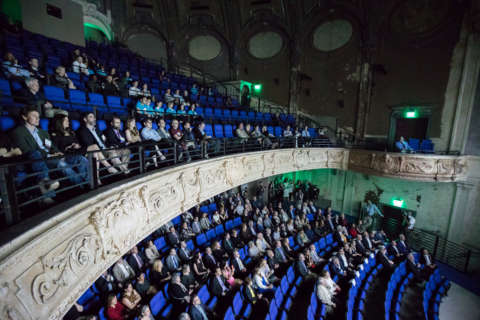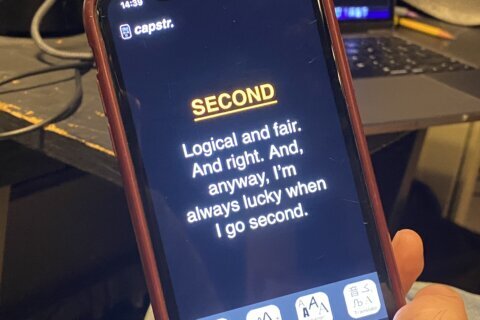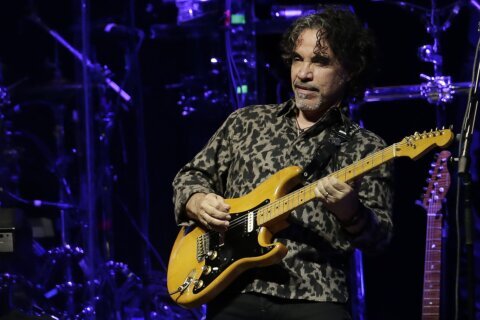He executive produced this month’s two hottest movies, “Joker” and “The Irishman,” so as Oscar season approaches, Richard Baratta has a quandary.
“Which table do I sit at?” Baratta joked with WTOP.
On Monday night, he’ll perform two concerts at historic Blues Alley in Georgetown.
“It’s contemporary jazz with some Latin jazz in there as well,” Baratta said. “The first 25 people for each show will get a free CD. … My mother was an opera singer and my father was a real good piano player, [so] I got the music from those two. I played a little saxophone, I played a little flute, but then I really got attached to the drums in my early teens. … I moved to New York City and played for a number of years, then about the mid-80s I just had a change of heart.”
That change of heart came when he caught the filmmaking bug in 1984, after a friend landed him a small gig on the crew of “Desperately Seeking Susan” (1985).
“I was just a P.A. in the location department and I didn’t like it,” Baratta said. “But then I got a call and did ‘Heartburn,’ which brought me to D.C., then I did ‘Big’ and ‘Working Girl.’ Next thing I know I became a production manager and did ‘Random Hearts,’ ‘Donnie Brasco’ and ‘Awakenings.’ Then I became a producer in ‘Maid in Manhattan,’ ‘Mona Lisa Smile’ and all the ‘Spider-Man’ movies, then I became an executive producer. That’s when my association with Marty [began].”
By “Marty” he of course means Martin Scorsese. After coproducing “The Wolf of Wall Street” (2013) for Scorsese’s Sikelia Productions, Baratta joined “Joker.”
“Marty was going to be a producer on ‘Joker’ way back when, so the production staffing ran through Sikelia,” Baratta said. “I met [director] Todd Phillips and he agreed that I should be the executive producer. … Todd wanted to mirror ‘Taxi Driver’ and ‘Mean Streets.’ … We recreated the look of the gritty ’70s in Times Square, even though we shot it in Newark because it still had the remnants of buildings that mimicked what Times Square looked like back in the ’70s.”
What does he make of the media controversy surrounding the film’s violence?
“I’m reading a lot of things in the press about how this could be a copycat thing — it’s really not about that,” Baratta said. “I’m seen many more violent movies. There are a lot of crazy people out there, but there are a lot more violent movies than ‘Joker.’ This movie is sad in a way and maybe, as opposed to getting the negative press that it’s getting, maybe it’ll do more good for the mentally ill than not because it’ll expose our system. There needs to be more services for people.”
Either way, it’s a frightfully realistic portrayal by Joaquin Phoenix.
“Phoenix is unbelievable in his role,” Baratta said. “It’s really a character study about a disenfranchised, mentally disturbed person who doesn’t get the care that a civilized society might give their mentally ill. … It’s got nothing to do with superheroes. [Jack] Nicholson’s approach was comical and campy, Heath Ledger was very dark and Joaquin is dark too. … Joaquin really immersed himself in the role. He lost about 45 pounds, so you can see his rib cage in parts of the movie.”
Robert DeNiro co-stars in a nod to Scorsese’s “The King of Comedy” (1982).
“He’s playing the counter character to him because Jerry Lewis was the character that DeNiro is now playing as a talk-show host [in ‘Joker’],” Baratta said. “It’s a complete reversal. Jerry Lewis was the king of comedy and now Robert DeNiro is a host like Jay Leno or Johnny Carson or Merv Griffin, so it’s a reversal.”
DeNiro also stars in Scorsese’s “The Irishman,” which makes its local premiere next week at the Middleburg Film Fest before hitting theaters Nov. 1 and Netflix on Nov. 27. Based on the book “I Heard You Paint Houses,” the gangster epic explores the disappearance of Jimmy Hoffa, played by Al Pacino across DeNiro and Joe Pesci, who reunite with Scorsese for the first time since “Casino” (1995).
“It’s really good,” Baratta said. “Marty had never worked with Pacino before, so bringing him on board to work with Pesci, DeNiro, Harvey Keitel and Ray Romano — that’s quite a cast. … It was very interesting and also a lot of fun to see Bob interact with Joe, then the newcomer Pacino interact with Joe and Bob, then Keitel come into the picture. It was a ‘who’s who’ of great, A-list, Academy Award-winning actors with Marty. It was fun to see them all together.”
The film uses a digitally de-aging process by Hollywood special effects house Industrial Light and Magic to show the characters at different points in time.
“I would liken it to ‘Benjamin Button’ in reverse,” Baratta said. “We didn’t want anybody worrying about the timeline. When you see Bob when he’s 40, he’s gotta look like he’s 45. When you see Bob at 25 during World War II in Italy, you don’t want to think, ‘He doesn’t look that age.’ … It’s not only the look, it’s also the posture. When the movie starts out, Bob is in his 30s and jumps down off a truck. He can’t look like a 74-year-old guy jumping, so we had a movement analyst.”
Not only is it an acting and technology marvel, it weaves in plenty of history.
“It’s about a man who’s given the job to protect Hoffa,” Baratta said. “He’s a very low-level Irish American who gets involved with the mafia and the connections between the mafia and John F. Kennedy, Joseph Kennedy and the Bay of Pigs. It hits on so many things. … It’s a very informative, historical depiction of a man who gets sucked into a certain lifestyle. I don’t want to reveal too much more, other than it’s funny, sad, violent, all the things you’d expect from the master.”
Instead of flashy pacing like “Goodfellas,” it’s a slowburn like “The Godfather.”
“It’s more subdued, it’s more stayed, there is narration,” Baratta said. “It starts right off with a very long Steadicam shot a la ‘Goodfellas’ at the Copacabana. Then there’s narration throughout by DeNiro and little freeze frames with descriptions of what happened to certain mobsters, which is pretty funny and revealing like a history lesson. The pace is a little slower, there’s lots of funny lines. [Oscar winner] Steve Zaillian wrote the script, so the dialogue is top rate.”
Where is the 76-year-old Scorsese at this point in his auteur career?
“He’s got a lot of energy and lives and breathes film,” Scorsese said. “He can tell you anything: the editor of a 1947 movie you might throw at him! … He’s like a Renaissance man. He’s adaptable, he’s very bright, he’s very perceptive and now he’s probably a little more reflective and I’m sure he approaches some things differently, but he’s always got the verve and enthusiasm to bring it to life, whether it’s religion, the mafia, rock ‘n roll; he’s pretty contemporary in his 70s.”
As for Baratta, he’s feeling the itch to try music in tandem with filmmaking.
“Three years ago, I decided I gotta get back to music,” Baratta said. “I got very fortunate and started hooking up with some real good musicians from the past and present. Now I’m with some of the greatest musicians in the world. I pinch myself to think that I’ve just made two movies that might be nominated for awards, then I’m also playing [music]. … I’m so lucky to play with such great people and have clubs like Blues Alley recognize it’s worthy of being performed.”
Find out more on the Blues Alley website. Hear our full conversation below:
Hear highlights from the on-air version below:








